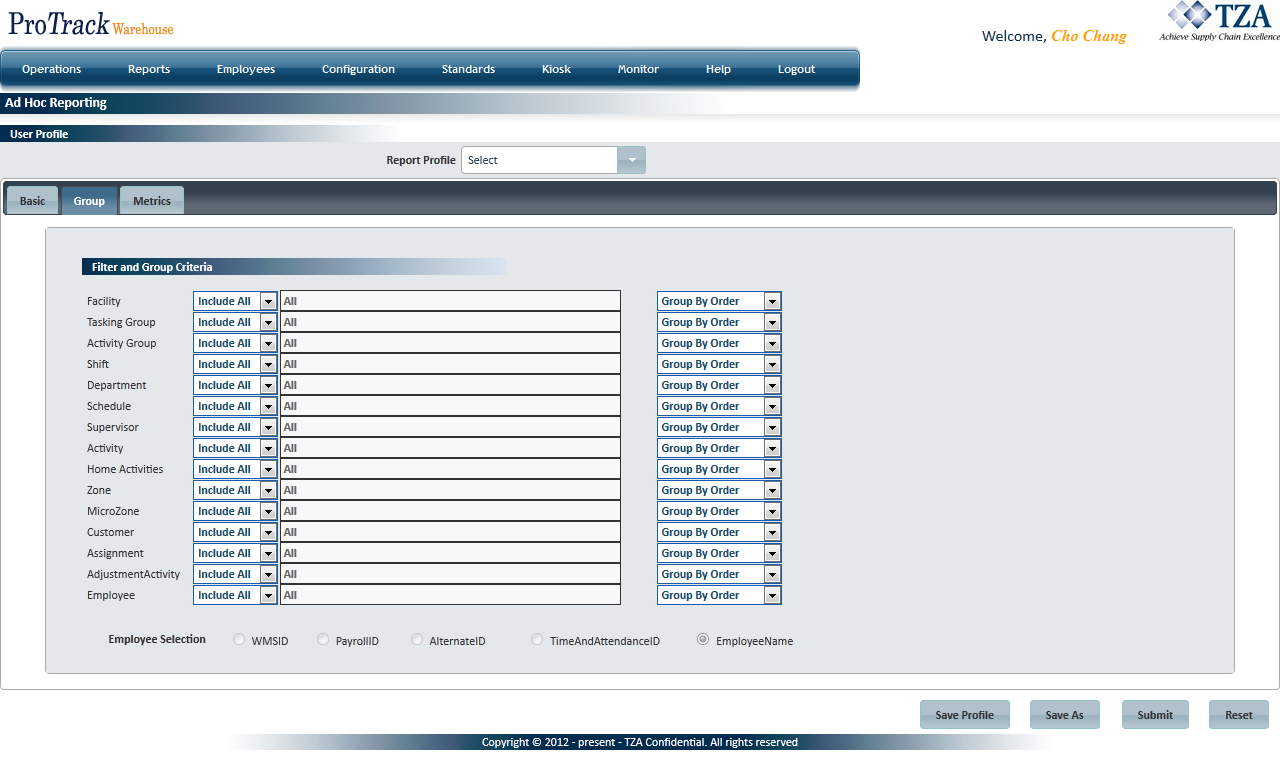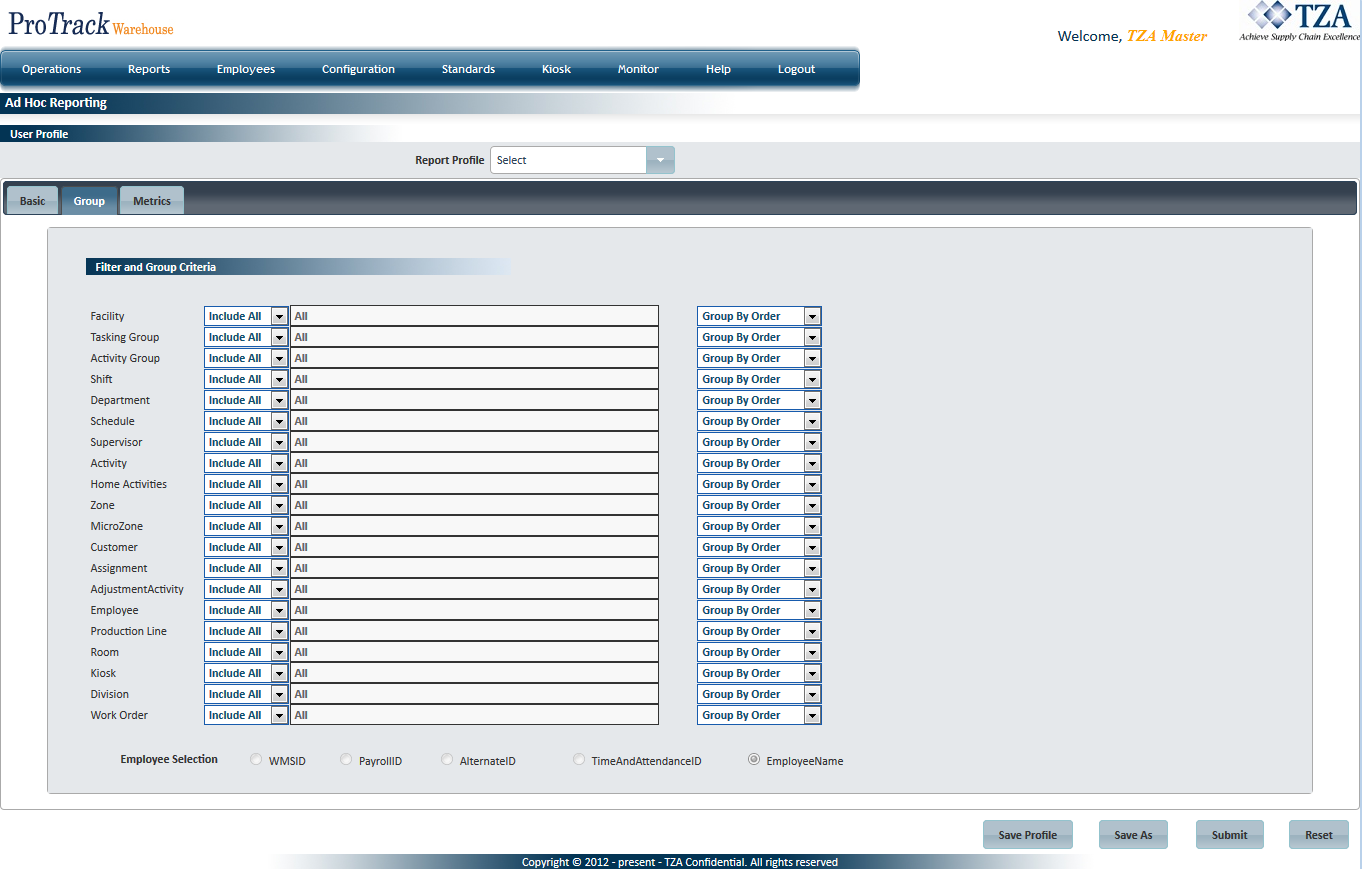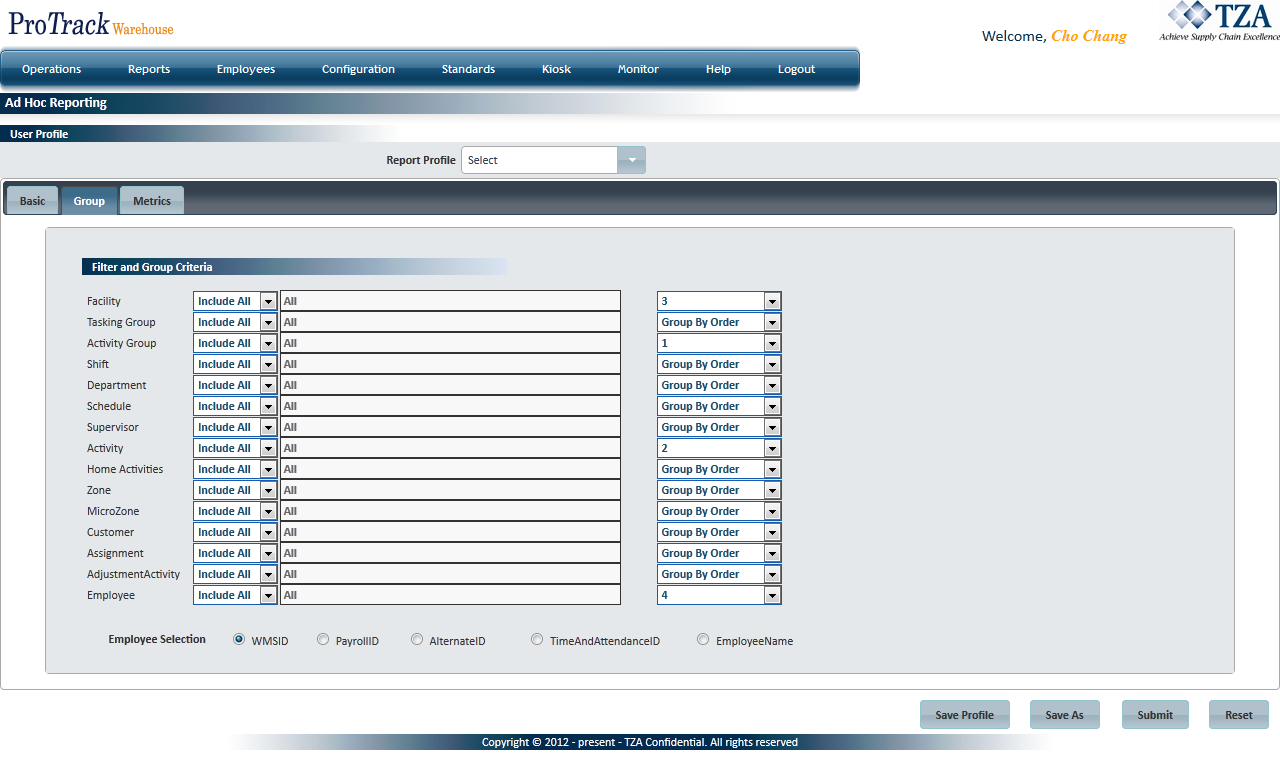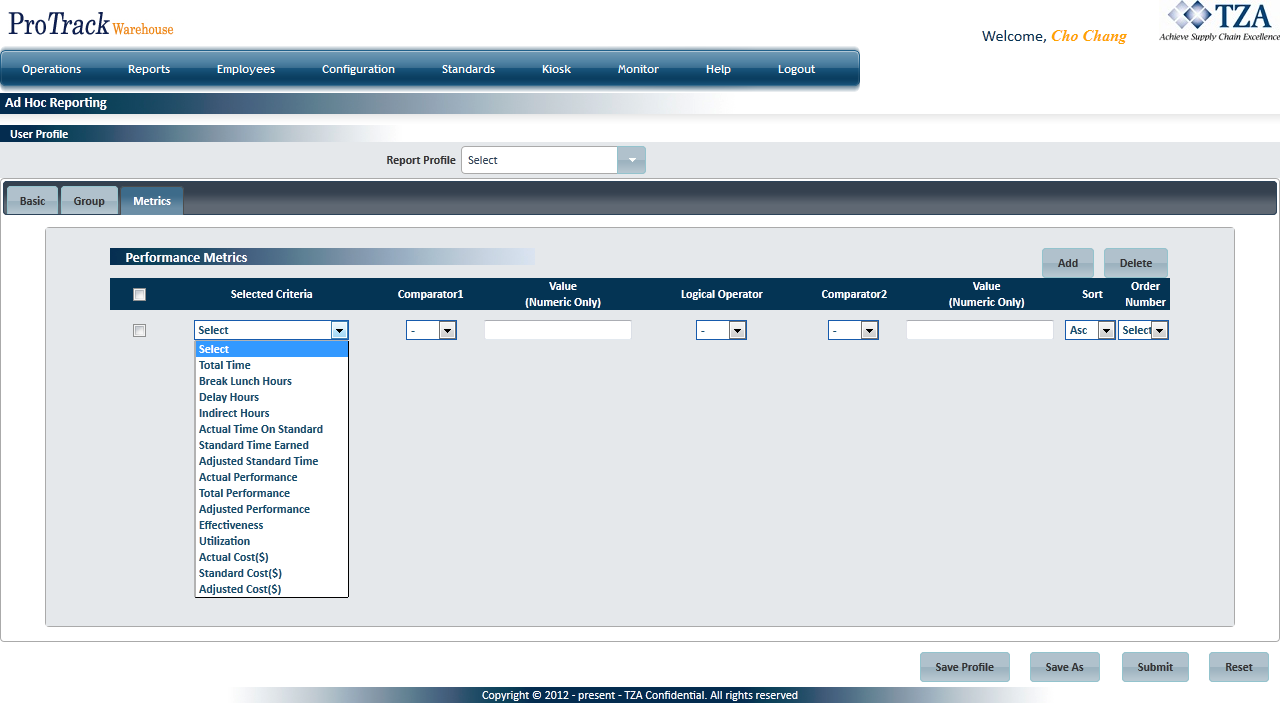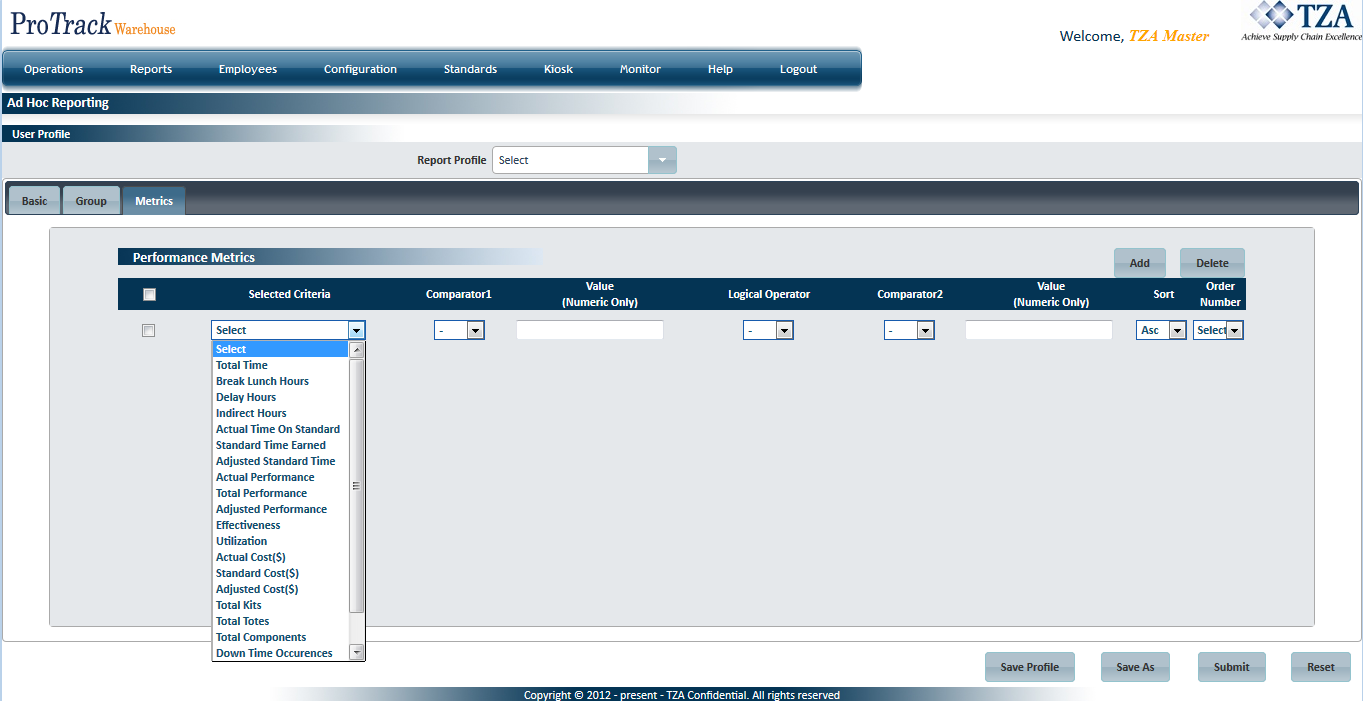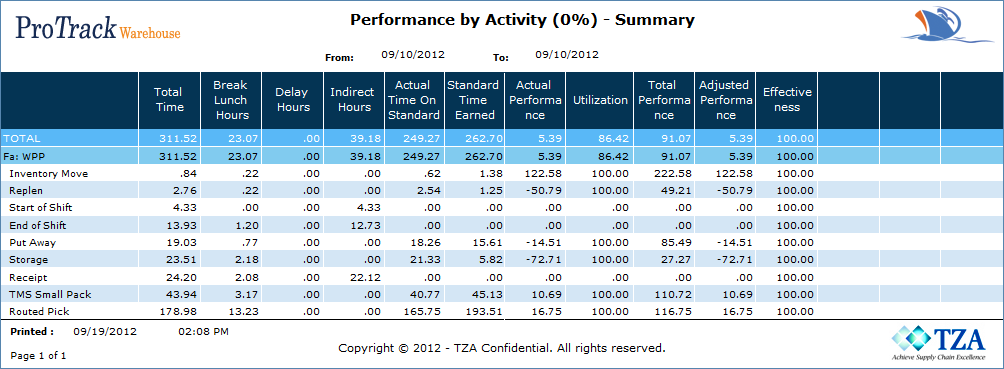[!ProTrack Warehouse Wiki^homepage-button_GRN_V3.png!]
Page History
...
On this tab the user filters and groups the data.
Fig.2 Ad Hoc Reporting - Group
...
- Facility
- Tasking Group
- Activity Group
- Shift
- Department
- Schedule
- Supervisor
- Activity
- Home Activities
- Zone
- Microzone
- Customer
- Employee
- Production Line - With Manufacturing Module
- Room - With Manufacturing Module
- Kiosk - With Manufacturing Module
- Division - With Manufacturing Module
- Work Order - With Manufacturing Module
To set up groups:
- Next to each of the items listed above, in the drop-down field on the left, choose whether or not to filter the data. By default, each is set to Include All data.
- Using the drop-down field, choose to Include or Exclude to filter specific values. When either is chosen, a spy-glass button appears to the right of the second field. Click here to specify particular values to either include or exclude. For example selecting to include the activities "Pick" and "Putaway" and excluding the Shift "First Shift" will result in all records for picking and putaway for employees not on first shift.
- After specific selections have been made, the user can reset back to "All" by clicking in the drop-down list and choosing "Include All".
- Use the "Group By Order" drop downs on the far right to summarize the data. Use these numbers to select which fields to group by, and the order to do so. The highest level of data summarization will be determined by the "Group by Order" with the lowest numerical value (1). The data will then be separated by the next lowest "Group by Order" value (2). This will repeat for as many of the "Group by Order" values that are selected. The largest group by value will be displayed as the detail portion of the report
1) Facility
2) Shift
3) EmployeeInfo title Info - A minimum of one "Group by Order" must be selected. The maximum number of groupings is 5.
- If Employeeis chosen to as a grouping, then the user must select the employee id that will be displayed on the report. The user id will default to the WMS employee id. The available values include:
- Last Name, First Name
- WMS id
- Time Attendance id
- Payroll id
- Alternate ID
An example to summarize this tab is shown below. Here the user has chosen the grouping hierarchy to be 1) Activity Group, 2) Activity, 3) Facility, 4) Employee. The user has also opted to display the detailed employee information, identifying employees by WMS ID.
Fig.3 Ad Hoc Reporting - Group Example
...
Click to add the desired metrics. Each metric will be added as a column on the report.
Fig.4 Ad Hoc Reporting - Performance MetricsSelect a Criteria from the drop down list.
Info title Info Listed below are the available Performance metrics:
- Total Time
- Break / Lunch Hours
- Delay Hours
- Indirect Hours
- Actual Time on Standard
- Standard Time Earned
- Adjusted Standard Time
- Actual Performance
- Total Performance
- Adjusted Performance
- Effectiveness
- Utilization
- Actual Cost ($) – employees' payrates × actual times on standard
- Standard Cost ($) – employees' payrates × standard times earned
- Adjusted Cost ($) – employees' payrates × adjusted standard times earned
- Total Kits - With Manufacturing Module
- Total Totes - With Manufacturing Module
- Total Components - With Manufacturing Module
- Down Time Occurrences - With Manufacturing Module
- Total Down Time - With Manufacturing Module
- Total People Assigned - With Manufacturing Module
- The next 5 columns are used to filter the data presented in the selected metric (if desired).
Comparator1 – a mathematical operator used in conjunction with the field to the right ("Value").
Info title Info Available comparators are:
- > (greater than)
- < (less than)
- = (equal to)
- <= (less than or equal to)
- >= (greater than or equal to)
- "–" is simply a placeholder meaning nothing is selected. It is not a subtraction sign.
- Value – used in conjunction with Comparator1. Enter a numeric value to constrain the data. For example if Comparator1 is set to "<" and "5" is typed into the Value field, only data which are less than 5 will be displayed on the report.
- Logical Operator: "AND", "OR". Use this column to join the previous two columns with an additional comparator and value in the next two columns.
- Comparator2 - an additional comparator.
- Value – used in conjunction with Comparator2.
- The next column is used to sort the data. Data can be sorted in either ascending or descending order.
- Select the order number of each metric. This is the column number in which the metric will appear. Columns appear left-to-right with number 1 being on the far left.
- If "Sort by Columns" was selected on the Basic screen, all reported data will first be sorted by the column on the far left (having an Order Number of "1"), and then by the second column, then third, etc… Thus it is important to place the column by which you want the data sorted on the far left (Order Number = 1). If "Sort by Groups" was selected on the Basic screen, the Sort option here has no effect.
- At the minimum, for each Metric that is added, a Criteria and Order Number must be selected. All comparators are optional.
- Click or on the far right to add or delete metrics.
- Once all of the metrics have been added, the report can either simply be run by clicking , or saved as a Report Profile.
Click and a popup window appears.
Fig.5 Ad Hoc Reporting - Save Profile- Type in a name for the report profile. Report Profile names MUST be unique across all users.
- If the profile was already previously saved, clicking will simply overwrite the existing profile settings without prompting for a Profile Name.
- Alternatively, if an existing profile has been edited, but you want to keep the original profile settings too, click button to bring up the Profile Name popup and save the Report Profile as a new name.
Click to generate the report.
Fig.6 Ad Hoc ReportingNote title Caution - Grand Total will be shown as the first row on the first page instead of the last row on the last page.
- Sub-Total will now be listed as the first row when a new grouping is presented. For example, Fig.122 shows the employee sub-total as the first row and the values that sum up to that total are listed underneath.
From there, the report can either be exported to a variety of formats by clicking .
Info title Info Available export formats include:
- Adobe Reader (.pdf)
- HTML
- Microsoft Excel (.xls)
- Text (.txt)
- Rich Text Format (.rtf)
- XML
- To print the report, click . The report will be generated in PDF format first and from there the report can be printed.
